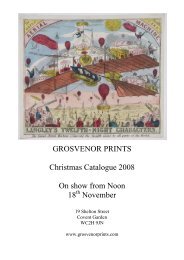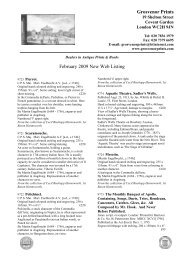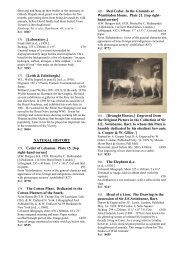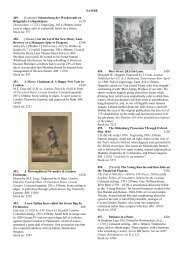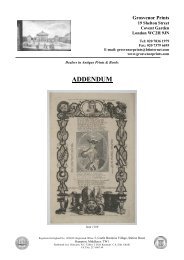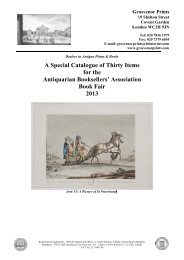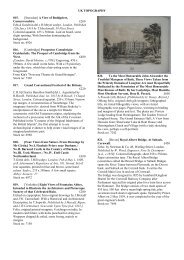06 London.pdf - Grosvenor Prints
06 London.pdf - Grosvenor Prints
06 London.pdf - Grosvenor Prints
You also want an ePaper? Increase the reach of your titles
YUMPU automatically turns print PDFs into web optimized ePapers that Google loves.
233. Part of the Bridge at Blackfriars. Asit was in July 1766.Edw.d Rooker delin et Sculp. Publish'd Accordijng toAct of Parliament by Edward Rooker, December the 311766.Engraving. 420 x 660mm. 16½ x 26". Mint. £850The first Blackfriars Bridge, built by Robert Milnefrom Portland stone, opening 1769.Ref: 9089234. Red Lyon Square.[n.d., c.1750.]Engraving. 165 x 245mm, 6½ x 8½". Tears in margins.£90Red Lion Square in Bloomsbury, named after the localinn. Laid out in 1698, it was described by Hatton in1708 as 'a pleasant square of good buildings, betweenHigh Holborn south and the fields north'. According tolegend the bodies of Oliver Cromwell and two otherregicides had been placed in a pit on the site of thesquare.Ref: 9233235. The Royal Military Asylum AtChelsea. For Soldiers Children of theRegular Army__Intended for 500 Girls &500 Boys.Published 20th. May, 1805, by Laurie & Whittle,No.53, Fleet Street, <strong>London</strong>.Etching and engraving coloured by hand, image 260 x405mm. 10¼ x 17¾". Trimmed to plate at top. Tearthrough title. £220View of the Royal Military Asylum, (Duke of York'sRoyal Military School) Chelsea, with soldiers, womenand children outside. The Asylum was opened as aschool for the children of soldiers. It is now the Dukeof York's Barracks.Ref: 8737236. A View of Chelsea Water Works. ~J. Boydell del & Sculp. Publish'd according to Act ofParliament by J. Boydell Engraver at the Unicorn theCorner of Queen Street, Cheapside. <strong>London</strong> 1752.Price 1s.Engraving. 430 x 260mm. Trimmed to plate and tippedinto album page. Vertical centre crease from fold. Astrong impression. £180The Chelsea Waterworks Company was formed in1723 and supplied water to Westminster and adjacentparts. It introduced the first iron main in <strong>London</strong> in1746. The company held water in reservoirs in HydePark and Green Park and pumped water through anelaborate sysstems of canals which covered a large areaof today's Pimlico. As the years marched by the waterwas becoming more and more contaminated and theCompany installed the first Sand filtration operation topurify the water. Eventurally in the late nineteenthcentury the company became part of the MetropolitanWater Board. Numbered 'No.5' lower right.This was reprinted in Boydell's "A collection of onehundred views in England and Wales" in 1770.Ref: 8739237. A Perspective View of CoventGarden. Vue de Covent Garden.Printed for Robert Wilkinson in Cornhil. & CaringtonBowles in St. Paul's Church Yard, <strong>London</strong> [n.d.,c.1750].Engraving and etching with hand colour, 250 x425mm. 9¾ x 16¾". Marginal staining. £450View of the piazza towards St Paul's church, with themarket in progress.Ref: 8755238. Crinoline 1858. Cremorne.T.H. Guerin [in image lower right]. Published by T.Archer [damage] Mortimer Street, Regent Street.Sepia tinted lithograph with colour added by hand,sheet 345 x 435mm. 13½ x 17". Creases; tear intopublication line. £180A satire on mid 19th century female fashion set inCremorne Gardens, once a popular pleasure gardens bythe side of the River Thames in Chelsea. A woman in ahuge dress descends from a carriage, the driver aboveensuring that his reins are well out of the way.Crinoline was originally a stiff fabric with a weft ofhorse-hair and a warp of cotton or linen thread. Thefabric first appeared around 1830, but by 1850 theword had come to mean a stiffened petticoat or rigidskirt-shaped structure of steel designed to support theskirts of a woman’s dress in the required shape. Thecrinoline was the subject of much ridicule and satire,particularly in Punch magazine. Dress reformers didnot like it either — they seized upon the cage aspect ofthe crinoline and claimed that it effectively imprisonedwomen. Given that the crinoline did eventually have amaximum diameter of up to 180 centimetres (six feet),it is easy to imagine difficulties in getting throughdoors, in and out of carriages, and the general problemsof moving in such a large structure. The secondproblem was the potential impropriety of the crinoline.Its lightness was a curse as well as a blessing, as a gustof wind or a knock could set it swinging and reveal thewearer's legs. Even worse, if a woman tripped or wasknocked over, the crinoline would hold her skirts up.Ref: 8997239. Crinoline 1858. Belgravia.T.H. Guerin. Del [in image lower left.] [<strong>London</strong>, T.Archer.]Sepia tinted lithograph with colour added by hand,sheet 315 x 415mm. 12½ x 16¼". Trimmed to imagetop and sides. £180A satire on mid 19th century female fashion. A womanin a huge dress rather awkwardly descends from a




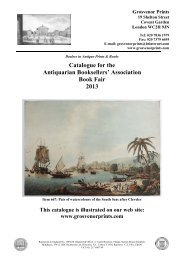
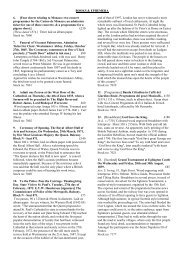
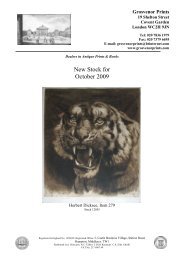
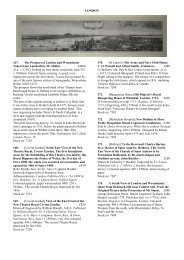
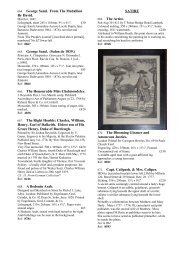
![FOREIGN TOPOGRAPHY 661. [Niagara] The ... - Grosvenor Prints](https://img.yumpu.com/38432042/1/184x260/foreign-topography-661-niagara-the-grosvenor-prints.jpg?quality=85)
